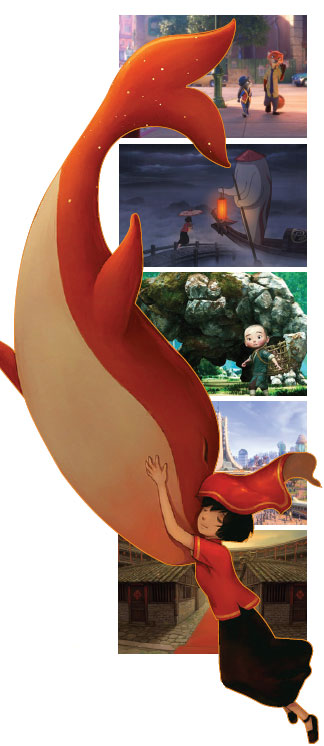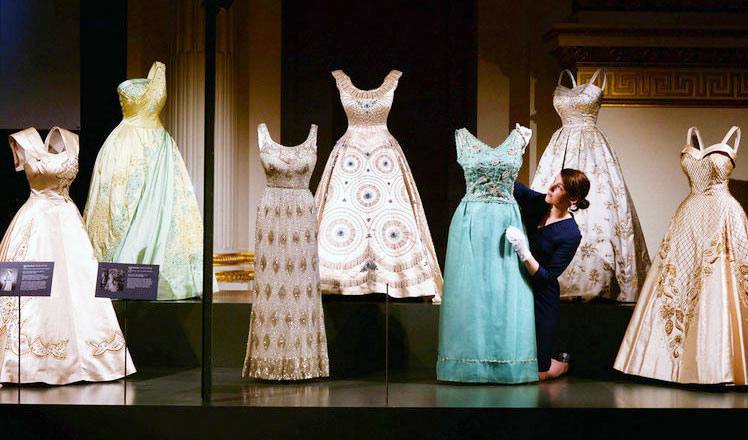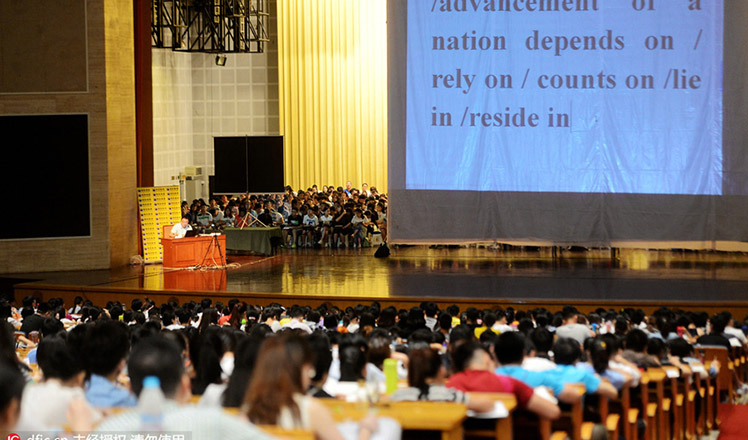Closing the Disney/Pixar Gap
Updated: 2016-07-22 10:50
By Amy He(China Daily USA)
|
||||||||
China's animation industry is changing, with box office receipts surging and studios seeking to become Chinese Disneys and Pixars. But critics say a gap remains with Western studios, especially in storytelling techniques, Amy He reports from New York.
When the Chinese animated film Big Fish and Begonia was released on July 8, it was the culmination of 12 years of work and some critics say it paid off. The film brought in $34 million in its opening weekend, beating even animated film Zootopia's opening weekend release in China of $23.6 million.
Big Fish and Begonia is a fantastical animation based on Chinese mythology, and was widely anticipated by a dedicated following that helped fund the movie when its filmmakers turned to crowdfunding for the project, raising $260,000 in 2013. The funding success piqued the interest of Enlight Media, which went on to provide complete funding for the rest of the film.
Film and animation industry experts say China is in the midst of an animation turnaround, after having played catch up for decades.
Despite not having famous studios like Disney and DreamWorks in the West, or Studio Ghibli in Japan, there are signs that animation in China is booming.
In the last three years, revenue for animated movies at China's box office nearly quadrupled, in part due to the success of American films but also because Chinese films are breaking records.
Domestic animated films generated about $300 million in box office revenue in 2015, a 78.6 percent increase over the prior year, according to statistics from the China International Cartoon and Animation Festival, which was held in Hangzhou in late April.
Of 57 animated films screened in China last year, 43 were domestic productions. Total ticket sales reached $657 million, up 45 percent year-on-year.

Monkey King: Hero is Back was the top-grossing animation in 2015, making $142 million. As of July, Disney's Zootopia is the second-largest film in China, having made $236 million.
The gap
Despite the increase in box office receipts and optimism about progress being made in the animation genre, industry experts say a gap remains between Western and Chinese artistic vision and technological capability that will take time to overcome.
"The gap in the technological quality has been shrinking dramatically year after year, but animation is different and much more difficult. It is an enormous opportunity for Chinese filmmakers if they can enhance the quality of the animation. It takes more time, more years to produce a major animation feature than it does a live-action feature," said Marc Ganis, founder of Jiaflix, which helps US studios distribute films in China.
"There's just a very significant technological disparity right now. I would expect that that will shrink, but it will take time to shrink," he added.
Observers say that China's animation skills have improved because of the government supporting the industry through subsidies and the trend of Chinese animation students going overseas and working at American companies like Disney and DreamWorks. Raman Hui, the head animator on Monster Hunt, had worked for years at DreamWorks Animation, producing for the Shrek franchise as well as Antz.
"The Chinese government's support of animation departments for the last 10 years, at so many colleges and universities across China, has been generous, well-placed and well-used," said David Ehrlich, an animation professor at Dartmouth College who also taught at the Beijing Film Academy.
"The result, that so many schools and studios are now at a technical level equal and often surpassing that of the other Asian and European industries, is well-earned," he said.
Stanley Rosen, director of the East Asian Studies Center at the University of Southern California, said that when Chinese animation students graduate, they "certainly want to get training in the US," often landing jobs at companies like Disney and Pixar.
Rushing productions
In addition to criticism about the low-quality of Chinese animation, there are claims that animated stories are not original. Critics point out that Western animated features often stay in development for years while creators tweak both the stories and the animated technology, something that happens with far less regularity in China.
"In the West, studios spend one or two years developing such aspects before beginning animation. Chinese studios spend much, much less time because budgets are so much smaller, and because there is not enough training or encouragement in these aspects," Ehrlich said.
Steven Brown, associate director of academic affairs at the Character Animation Program at CalArts, said that Monkey King is the "best Chinese animated feature in recent times" because it was in development for eight years.
"But its quality and box office success show that it was worth the investment of time. It should be an object lesson to other Chinese animation producers," though he said that the culture of rushing films to production in China is too strong.
The increase in appetite for animated movies in China is a good chance for Chinese film studios to capitalize on the children's market, and it also represents the one genre where a Chinese production could potentially succeed overseas in ways that its blockbusters cannot, industry experts said.
"There is more consumption and studios are ramping up interest in animation in China," said Ganis.
Animated films appeal to children, which in the West in particular has been a "very valuable and consistent market," he said. "There's a feeling that as there's more of a consumer-driven society, more of an openness in the types of films that people go see, that children's movies is a relatively untapped vein of gold."
What's even better about the children's segment is that every decade or so, an "entirely new market that has not been introduced to the characters" can be told the same stories, allowing studios to rerelease stories over and over again, he said. Where adults want variety in their media, children want consistency, added Ganis.
"I know some parents have gotten so sick of hearing the same songs from [Disney's] Frozen over and over again - it drives them up a wall, but the young kids love it," he joked.
Releasing children's stories also presents revenue opportunities, such as merchandising for clothing and toys, and turning feature animations into shorter-length cartoon series for television.
Some attribute the success of animated films in China to the growing number of screens in the country, as well as the changing way Chinese families consume media.
"As construction of theaters has broadened out to the smaller cities, it's become a family thing to go to the movies," said Rob Cain, partner in film coproduction company Pacific Bridge Pictures.
Rosen said that China's lack of a movie-ratings system also helps to give them a boost at the box office.
"There's still some concern when you go to the theater over whether a movie is suitable for children or not. That's not the kind of thing you have to worry about with an animated film - they won't hear a bad word or see sex scenes, implied or otherwise," he said. "Animated films are safe films to take children to."
- Fashion of Queen Elizabeth on exhibition in London
- Hollande urges Britain to begin EU exit talks 'as soon as possible'
- Trump vows law and order if elected
- Chinese cuisine stuns Thai princess
- Security Council holds first secret poll on next UN chief selection
- Turkey's Erdogan declares state of emergency after coup bid

 Things you may not know about Major Heat
Things you may not know about Major Heat
 Unveiling the secrets of Elizabeth II’s wardrobe
Unveiling the secrets of Elizabeth II’s wardrobe
 Go global: Wanda's top 10 foreign acquisitions
Go global: Wanda's top 10 foreign acquisitions
 Hot pepper and ice tub challenge held in E China
Hot pepper and ice tub challenge held in E China
 Ten photos from around China: July 15 – 21
Ten photos from around China: July 15 – 21
 Heavy rain, floods across China
Heavy rain, floods across China
 Super-sized class has 3,500 students for postgraduate exam
Super-sized class has 3,500 students for postgraduate exam
 Luoyang university gets cartoon manhole covers
Luoyang university gets cartoon manhole covers
Most Viewed
Editor's Picks

|

|

|

|

|

|
Today's Top News
Ministry slams US-Korean THAAD deployment
Two police officers shot at protest in Dallas
Abe's blame game reveals his policies failing to get results
Ending wildlife trafficking must be policy priority in Asia
Effects of supply-side reform take time to be seen
Chinese State Councilor Yang Jiechi to meet Kerry
Chinese stocks surge on back of MSCI rumors
Liang avoids jail in shooting death
US Weekly

|

|







